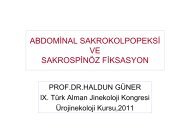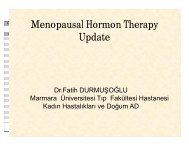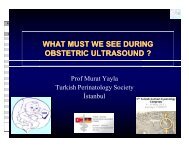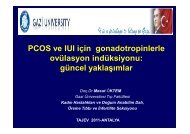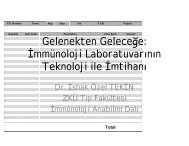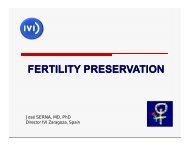Thomas Ebner_Zona pellucida imaging.ppt [Uyumluluk Modu]
Thomas Ebner_Zona pellucida imaging.ppt [Uyumluluk Modu]
Thomas Ebner_Zona pellucida imaging.ppt [Uyumluluk Modu]
You also want an ePaper? Increase the reach of your titles
YUMPU automatically turns print PDFs into web optimized ePapers that Google loves.
ZONA PELLUCIDA IMAGING<br />
P.O. Number Terms Rep Ship Via F.O.B. Project<br />
as a predictive factor in IVF laboratories<br />
Quantity Item Code Description Price Each Amount<br />
<strong>Thomas</strong> <strong>Ebner</strong><br />
Kinderwunsch Klinik Linz<br />
AUSTRIA<br />
Total<br />
IX. Turkish-German Gynecology Congress<br />
Antalya<br />
4.-8. May, 2011
FOLLICULOGENESIS<br />
primordial follicle<br />
primary follicle<br />
secondary follicle<br />
secondary follicle<br />
tertiary follicle
SECONDARY FOLLICLE
3D-STRUCTURE<br />
ZP1 185-200 kDa<br />
ZP2 120-140 kDa<br />
ZP3 83 kDa<br />
<strong>Zona</strong> <strong>pellucida</strong><br />
ZP3<br />
Wassarman, 1989
COMMUNICATION through ZONA<br />
Sutton et al., 2003
ZONA THICKNESS<br />
… increases during MATURATION<br />
and<br />
… decreases after FERTILIZATION<br />
ZP1 gene<br />
½ THIN ZONA<br />
ZP2 and 3 gene<br />
No ZONA<br />
-sterile-
HYPOTHESIS<br />
In such oocytes with zona defects,<br />
the patterning or the secretion of the glycoprotein could have been interrupted<br />
during the formation of the extracellular coat . . .<br />
In contrast,<br />
normal zona appearance might reflect optimal growth and nutrition of the egg<br />
and, thus, could be related to oocyte developmental competence . . .<br />
oocyte<br />
oocyte/ granulosa cells<br />
granulosa cells
HOW to QUANTIFY<br />
Shen et al., 2005<br />
• Polarization microscopy allows for visualization of highly ordered structures,<br />
such as spindle and zona <strong>pellucida</strong><br />
• <strong>Zona</strong> <strong>pellucida</strong>, e.g., shows a distinct laminar architecture consisting of an<br />
inner (bright), a middle (black) and an outer layer (grey)<br />
– THICKNESS of the 3 layers<br />
– BIREFRINGENCE / RETARDATION
FIRST EVIDENCE<br />
Shen et al., 2005<br />
Inner layer is the thickest one and shows the highest retardance
VARIATION<br />
Shen et al., 2005<br />
17%<br />
8.5% (±8.5)<br />
maximum difference<br />
average<br />
45%<br />
16.5% (±14.5)
ZONA and PREGNANCY<br />
Shen et al., 2005<br />
2.8±0.6<br />
11.3±1.4<br />
0.4±0.1<br />
3.9±0.8<br />
0.6±0.2<br />
4.8±1.4<br />
INNER LAYER<br />
Retardance (nm)<br />
Thickness (µm)<br />
MIDDLE LAYER<br />
Retardance (nm)<br />
Thickness (µm)<br />
OUTER LAYER<br />
Retardance (nm)<br />
Thickness (µm)<br />
2.2±0.4<br />
9.4±1.7<br />
0.4±0.1<br />
3.7±0.7<br />
0.6±0.1<br />
5.6±1.0
RETARDANCE and THICKNESS<br />
Pelletier et al., 2004<br />
a thin zona <strong>pellucida</strong> corresponds to a low retardance
CONCLUSION<br />
Shen et al., 2005<br />
• oocytes from cycles resulting in a pregnancy appear<br />
to have a more homogeneous zona morphology<br />
compared to oocytes from unsuccessful cycles.<br />
• theoretically, a thicker zona could better protect<br />
against ICSI damage<br />
• eggs with a higher retardance derive from optimal<br />
follicles
ZONA and BLASTOCYST FORMATION<br />
Rama Raju et al., 2007<br />
<strong>Ebner</strong> et al., 2005<br />
Shen et al., 2005<br />
INNER LAYER THICKNESS: 53% BFR (10-12nm) vs. 22% (3µm) vs. 17% (
PROSPECTIVE APPROACH<br />
Montag et al., 2008<br />
FERTILIZATION: 74% 68% 68%<br />
IMPLANTATION: 40% 26% 13%<br />
PREGNANCY: 65% 50% 25%
OCTAX polarAIDE<br />
• involves an automatic mode of zona analysis<br />
• the system automatically detects the zona <strong>pellucida</strong><br />
• birefringence/thickness are quantified within seconds<br />
• an internal algorithm deduces a score from the values<br />
• based on the empirical work of M. Montag<br />
• positive scores appear green, negative ones red
ZONA and MATURITY<br />
PI<br />
P=0. 018<br />
MI<br />
Score: 20.5±6.6 Score: 16.8±4.9<br />
P
FAILURE of MEASUREMENT<br />
oocyte shape<br />
ZG<br />
positive: 23% negative: 14%<br />
granulosa cells<br />
MATURITY<br />
OOCYTE QUALITY
… automatic zp detection failure seems to be a negative prognostic parameter
Oocyte quality might be affected by stimulation protocol
ZONA and PREGNANCY<br />
RATE of VALID MEASUREMENTS<br />
all oocytes<br />
48/222 (21.6%)<br />
vs<br />
155/429 (36.1%)<br />
MII-oocytes<br />
42/193(21.8%)<br />
vs<br />
148/377 (39.3%)<br />
P=0.002<br />
P
ZONA and PREGNANCY II<br />
SCORES<br />
ALL OOCYTES<br />
12.4 P=0.078 11.4<br />
MII OOCYTES<br />
12.0 P=0.066 10.9<br />
ET / BT<br />
11.6 P=0.14 9.7<br />
100% IMPLANTATION
Thanks for your attention<br />
Prof. Dr. Gernot TEWS<br />
Dr. Johannes HARTL<br />
Dr. Omar SHEBL<br />
Dr. Richard B. MAYER<br />
Dr. Andreas SIR<br />
Dr. Veronika KRAIN<br />
Dr. Marianne MOSER<br />
Fr. Manuela PUCHNER<br />
Fr. Renate WIESINGER


![Thomas Ebner_Zona pellucida imaging.ppt [Uyumluluk Modu]](https://img.yumpu.com/32247200/1/500x640/thomas-ebner-zona-pellucida-imagingppt-uyumluluk-modu.jpg)
![Engin Oral_Konjenital uterus anomalileri.ppt [Uyumluluk Modu]](https://img.yumpu.com/51729800/1/190x146/engin-oral-konjenital-uterus-anomalilerippt-uyumluluk-modu.jpg?quality=85)
